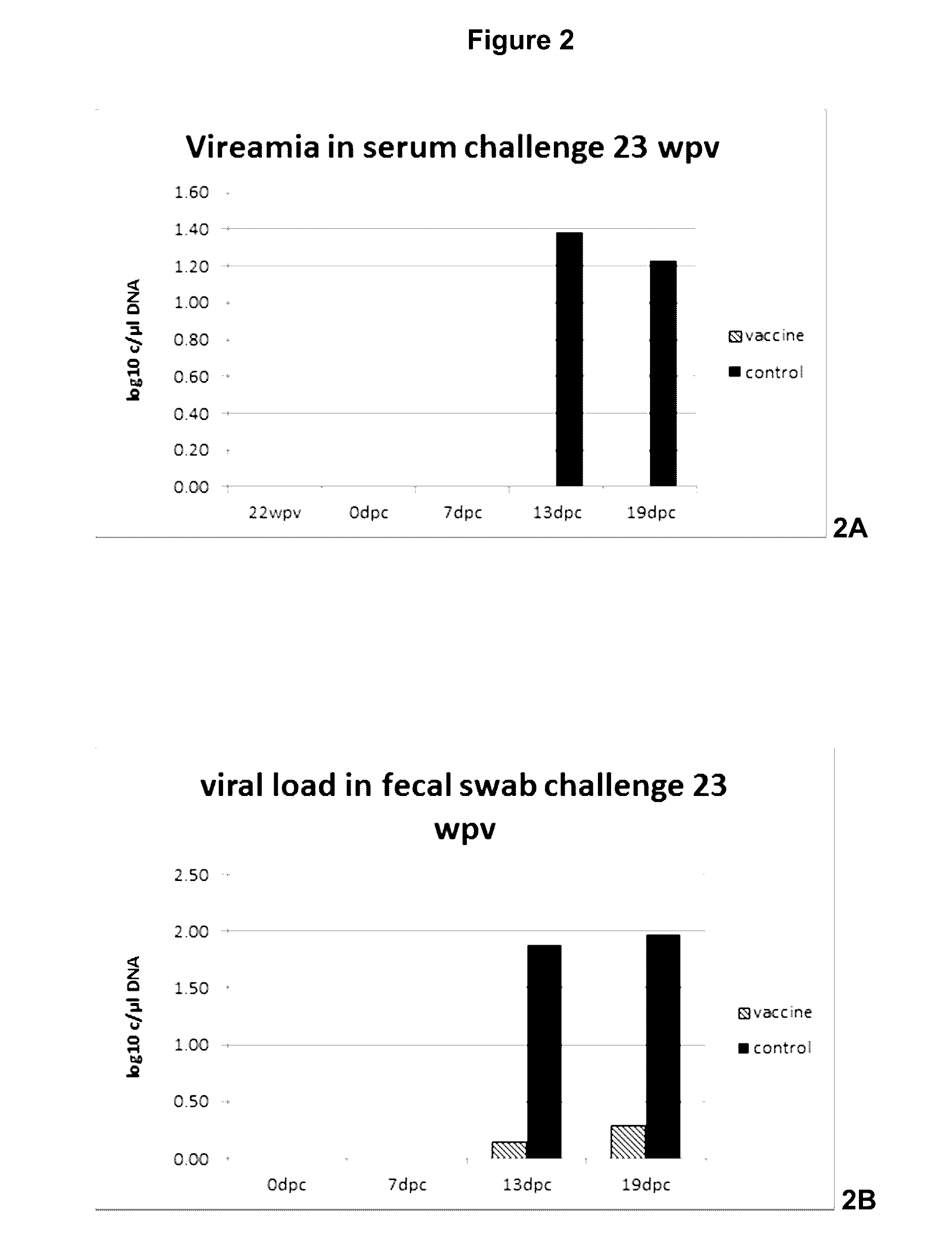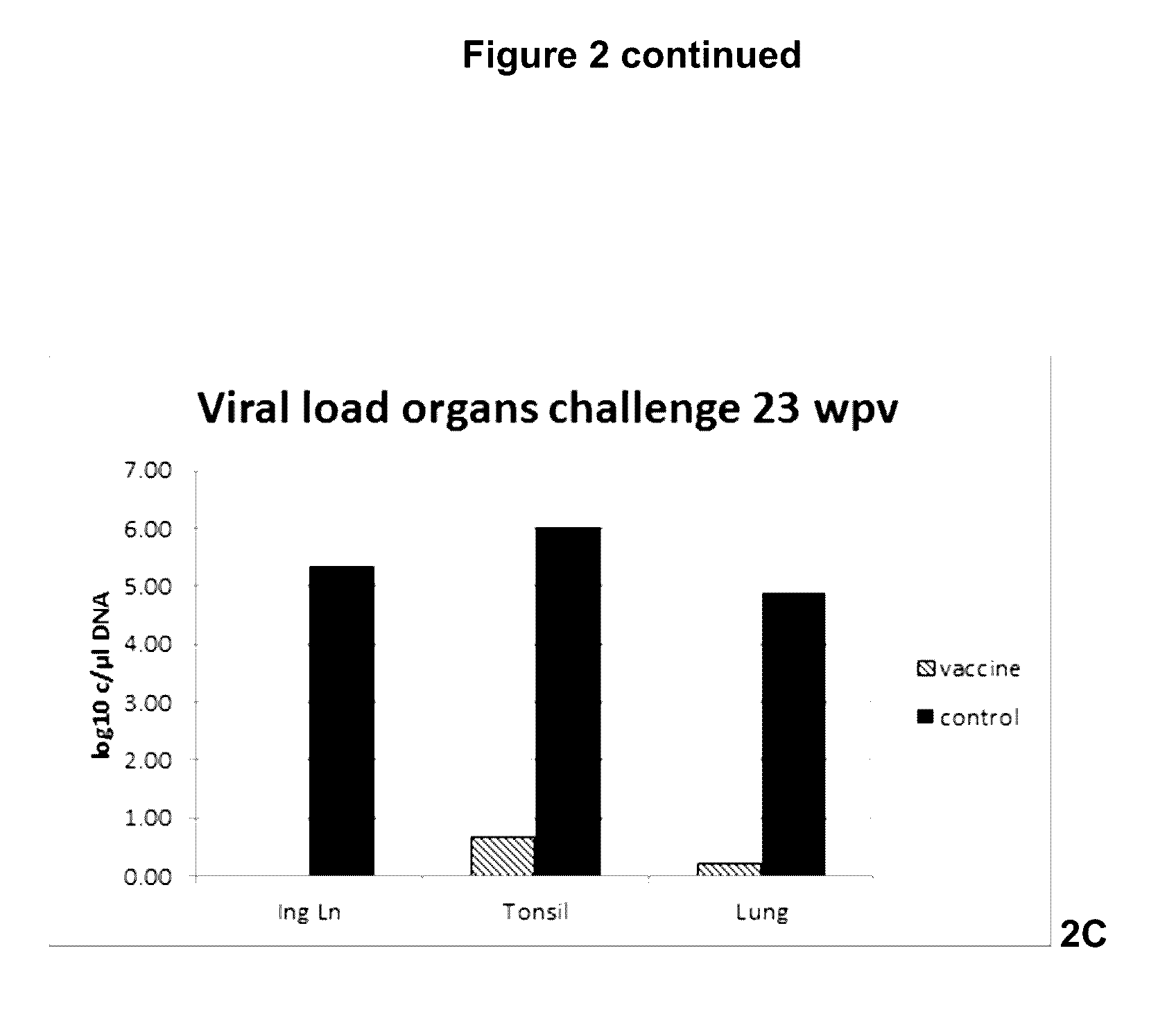Vaccine against lawsonia intracellularis and porcine circovirus 2
a technology of porcine circovirus and vaccine, applied in the field of porcine health, can solve the problems of large economic loss, inability to commercialize, and uncertainty in the safety and efficacy of combination vaccines, and achieve the effect of reducing vaccine efficacy and increasing local adverse reactions
- Summary
- Abstract
- Description
- Claims
- Application Information
AI Technical Summary
Benefits of technology
Problems solved by technology
Method used
Image
Examples
examples
[0025]Example 1 is an experiment to show that a single dose intradermal vaccination can provide twenty three weeks of immunity against an infection with porcine circo virus type 2.
[0026]Example 2 is another experiment with a PCV2 ID once vaccination approach showing that vaccination is safe and leads to protective titers.
[0027]Example 3 is a direct comparison between intradermal and intramuscular vaccination.
[0028]Example 4 describes experiments with combined intradermal vaccination.
[0029]Example 5 describes an experiment with combination vaccines, various antigen dosages and various adjuvants.
[0030]Example 6 describes a further experiment with combination vaccines.
[0031]FIG. 1 Serology in a DOI study
[0032]FIG. 2 Viral load in serum, feces and organs
[0033]FIG. 3 Average body temperatures
[0034]FIG. 4 Average total PCV2 Ig Ab results
[0035]FIG. 5 Average PCV2 IgM Ab results
[0036]FIG. 6 Antibody titers in a duration study
[0037]FIG. 7 Viral load in organs
[0038]FIG. 8 Viral load in organs...
example 1
Experimental Design
[0039]Progeny of 10 sows with antibodies against PCV2 were used for this study. Piglets were divided across litters into 2 groups of 15 animal animals. At 3 weeks of age, the piglets of group 1 were vaccinated intradermally on the right side of the neck with 0.2 ml of a vaccine comprising recombinantly expressed ORF2 protein of porcine circo virus type 2 (see WO 2007 / 028823 for the provision of the protein), using the commercially available intradermal vaccination device IDAL® (available from MSD Animal Health, Boxmeer, The Netherlands), while group 2 was left unvaccinated and served as a control group. All study animals were observed daily for clinical signs. Blood samples of all animals were taken at time of vaccination, 9, 17, 19 and 21 weeks later. Twenty-three weeks following vaccination each animal was challenge infected using a wild-type PCV2 challenge virus strain applied intranasally.
[0040]Serum samples and fecal swabs were taken one day before challenge ...
example 2
Experimental Design
[0051]A total of 46 piglets from one farrowing batch were allotted to 4 treatment groups: two vaccinated groups of 13 piglets each and two control groups of 10 piglets. Group one was vaccinated as indicated above under Example 1 when the piglets were approximately two weeks old, group two was vaccinated when the piglets were approximately three weeks old. The piglets were intradermally vaccinated in the right side of the neck with a single dose of vaccine. Groups 3 (control group 2 week old animals) and 4 (control group 3 week old animals) were not vaccinated. Serum samples were collected from all animals on the day of vaccination, 2, 3 and 4 weeks after vaccination. Temperatures were taken one day before vaccination, at the day of vaccination and four hours later and at 1, 2, 3, 4 days post vaccination.
Experimental Procedure
[0052]Before vaccination, the piglets were observed for general health. Body temperatures were taken of all piglets, on day T=−1, day T=0 at ...
PUM
| Property | Measurement | Unit |
|---|---|---|
| v/v | aaaaa | aaaaa |
| size | aaaaa | aaaaa |
| compatibility | aaaaa | aaaaa |
Abstract
Description
Claims
Application Information
 Login to View More
Login to View More - R&D
- Intellectual Property
- Life Sciences
- Materials
- Tech Scout
- Unparalleled Data Quality
- Higher Quality Content
- 60% Fewer Hallucinations
Browse by: Latest US Patents, China's latest patents, Technical Efficacy Thesaurus, Application Domain, Technology Topic, Popular Technical Reports.
© 2025 PatSnap. All rights reserved.Legal|Privacy policy|Modern Slavery Act Transparency Statement|Sitemap|About US| Contact US: help@patsnap.com



